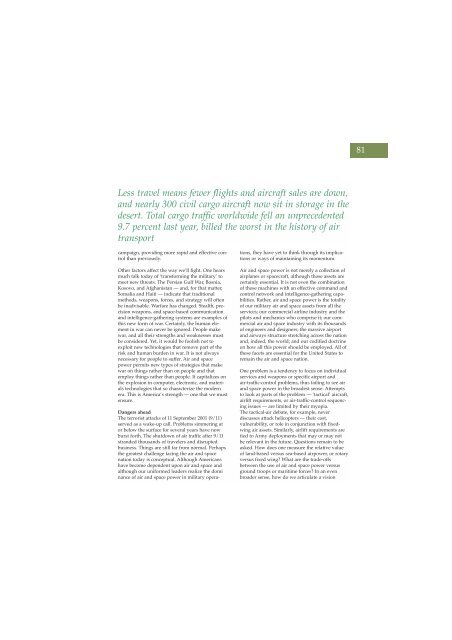Volume 6 No 4 - Royal Air Force Centre for Air Power Studies
Volume 6 No 4 - Royal Air Force Centre for Air Power Studies
Volume 6 No 4 - Royal Air Force Centre for Air Power Studies
You also want an ePaper? Increase the reach of your titles
YUMPU automatically turns print PDFs into web optimized ePapers that Google loves.
81<br />
Less travel means fewer flights and aircraft sales are down,<br />
and nearly 300 civil cargo aircraft now sit in storage in the<br />
desert. Total cargo traffic worldwide fell an unprecedented<br />
9.7 percent last year, billed the worst in the history of air<br />
transport<br />
campaign, providing more rapid and effective control<br />
than previously.<br />
Other factors affect the way we’ll fight. One hears<br />
much talk today of ‘trans<strong>for</strong>ming the military’ to<br />
meet new threats. The Persian Gulf War, Bosnia,<br />
Kosovo, and Afghanistan — and, <strong>for</strong> that matter,<br />
Somalia and Haiti — indicate that traditional<br />
methods, weapons, <strong>for</strong>ces, and strategy will often<br />
be inadvisable. Warfare has changed. Stealth, precision<br />
weapons, and space-based communication<br />
and intelligence-gathering systems are examples of<br />
this new <strong>for</strong>m of war. Certainly, the human element<br />
in war can never be ignored. People make<br />
war, and all their strengths and weaknesses must<br />
be considered. Yet, it would be foolish not to<br />
exploit new technologies that remove part of the<br />
risk and human burden in war. It is not always<br />
necessary <strong>for</strong> people to suffer. <strong>Air</strong> and space<br />
power permits new types of strategies that make<br />
war on things rather than on people and that<br />
employ things rather than people. It capitalizes on<br />
the explosion in computer, electronic, and materials<br />
technologies that so characterize the modern<br />
era. This is America’s strength — one that we must<br />
ensure.<br />
Dangers ahead<br />
The terrorist attacks of 11 September 2001 (9/11)<br />
served as a wake-up call. Problems simmering at<br />
or below the surface <strong>for</strong> several years have now<br />
burst <strong>for</strong>th. The shutdown of air traffic after 9/11<br />
stranded thousands of travelers and disrupted<br />
business. Things are still far from normal. Perhaps<br />
the greatest challenge facing the air and space<br />
nation today is conceptual. Although Americans<br />
have become dependent upon air and space and<br />
although our uni<strong>for</strong>med leaders realize the domi<br />
nance of air and space power in military operations,<br />
they have yet to think through its implications<br />
or ways of maintaining its momentum.<br />
<strong>Air</strong> and space power is not merely a collection of<br />
airplanes or spacecraft, although those assets are<br />
certainly essential. It is not even the combination<br />
of those machines with an effective command and<br />
control network and intelligence-gathering capabilities.<br />
Rather, air and space power is the totality<br />
of our military air and space assets from all the<br />
services; our commercial airline industry and the<br />
pilots and mechanics who comprise it; our commercial<br />
air and space industry with its thousands<br />
of engineers and designers; the massive airport<br />
and airways structure stretching across the nation<br />
and, indeed, the world; and our codified doctrine<br />
on how all this power should be employed. All of<br />
these facets are essential <strong>for</strong> the United States to<br />
remain the air and space nation.<br />
One problem is a tendency to focus on individual<br />
services and weapons or specific airport and<br />
air-traffic-control problems, thus failing to see air<br />
and space power in the broadest sense. Attempts<br />
to look at parts of the problem — ‘tactical’ aircraft,<br />
airlift requirements, or air-traffic-control sequencing<br />
issues — are limited by their myopia.<br />
The tactical-air debate, <strong>for</strong> example, never<br />
discusses attack helicopters — their cost,<br />
vulnerability, or role in conjunction with fixedwing<br />
air assets. Similarly, airlift requirements are<br />
tied to Army deployments that may or may not<br />
be relevant in the future. Questions remain to be<br />
asked. How does one measure the relative value<br />
of land-based versus sea-based airpower, or rotary<br />
versus fixed wing? What are the trade-offs<br />
between the use of air and space power versus<br />
ground troops or maritime <strong>for</strong>ces? In an even<br />
broader sense, how do we articulate a vision
















